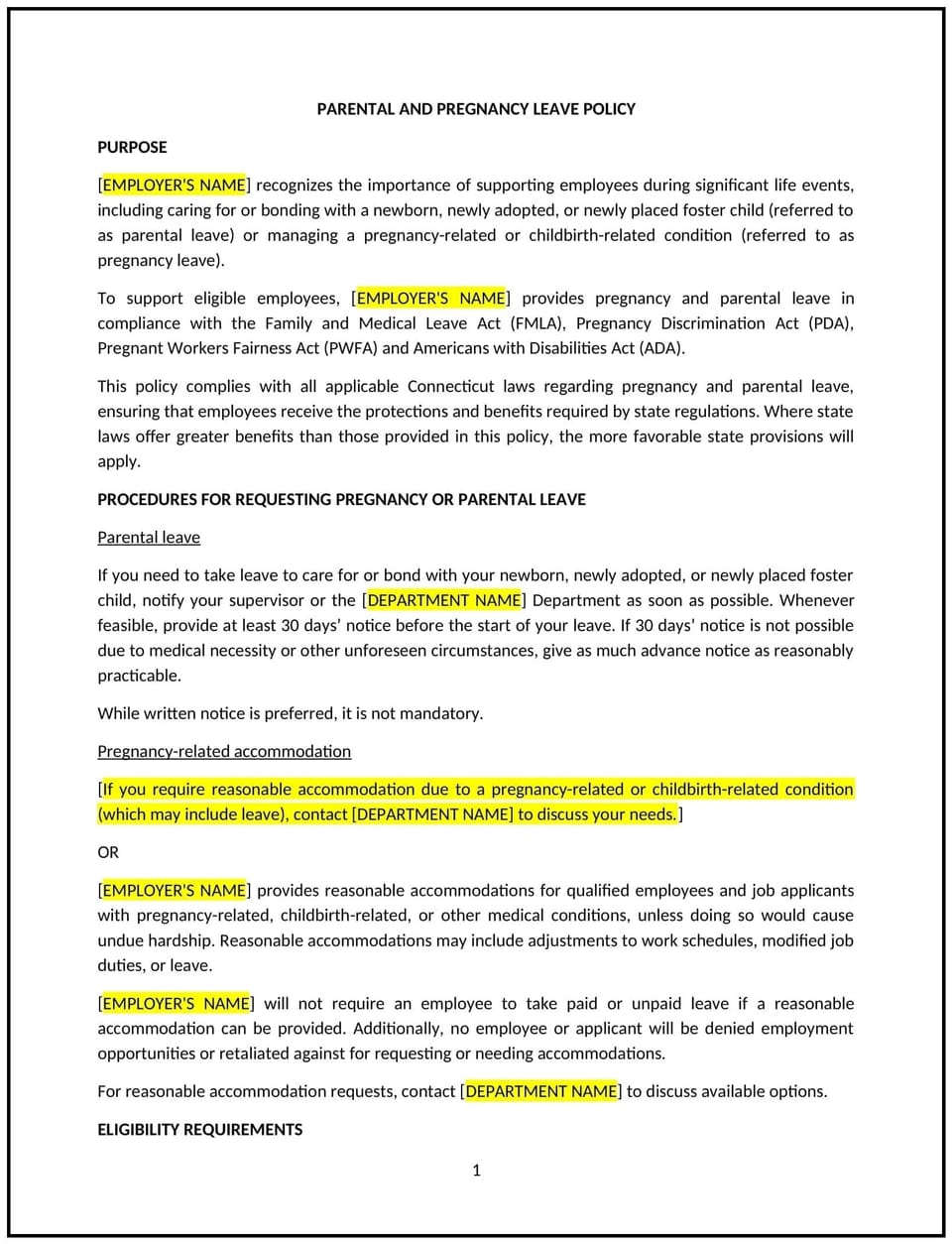Parental and pregnancy leave policy (Connecticut): Free template

Parental and pregnancy leave policy (Connecticut)
A parental and pregnancy leave policy helps Connecticut businesses comply with state and federal laws while providing employees with the time off they need to care for a newborn, adopted child, or address pregnancy-related medical needs. This policy outlines the company’s commitment to supporting employees during pregnancy, childbirth, and early parenting, ensuring that they can balance family responsibilities with their professional duties.
By implementing this policy, businesses can promote a supportive and inclusive workplace, retain valuable employees, and comply with applicable state and federal leave laws.
How to use this parental and pregnancy leave policy (Connecticut)
- Define eligibility: Specify the employees who are eligible for parental and pregnancy leave, including the duration of employment required for eligibility and the amount of time off allowed under state and federal law.
- Outline pregnancy-related leave: Provide guidelines for pregnancy-related medical leave, including time off for prenatal appointments, recovery after childbirth, and any necessary accommodations during pregnancy.
- Detail parental leave benefits: Outline the benefits available to employees taking parental leave, including the duration of leave, whether the leave is paid or unpaid, and whether the employee is required to use accrued leave (such as vacation or sick time).
- Clarify job protection: Ensure that employees understand their job will be protected during parental and pregnancy leave and outline the process for returning to their position after leave, in compliance with Connecticut and federal laws.
- Include health benefits: Clarify how health insurance and other benefits will be handled during the leave period, and provide information on any additional benefits offered to employees on parental leave.
- Address the interaction with other leave policies: Ensure the policy addresses how parental and pregnancy leave interacts with other leave policies, such as Family and Medical Leave Act (FMLA) leave or Connecticut Paid Family and Medical Leave (PFML) benefits.
Benefits of using this parental and pregnancy leave policy (Connecticut)
This policy offers several benefits for Connecticut businesses:
- Complies with state and federal regulations: Ensures the business meets the requirements of the Family and Medical Leave Act (FMLA) and Connecticut Paid Family and Medical Leave (PFML), reducing the risk of legal penalties.
- Supports employees’ well-being: By providing paid or unpaid leave, the policy supports employees during pregnancy and childbirth, improving job satisfaction and fostering a positive work-life balance.
- Enhances retention: Offering parental leave helps businesses retain employees after major life events, reducing turnover and fostering loyalty.
- Promotes an inclusive culture: Demonstrates the company’s commitment to diversity and inclusion by supporting both male and female employees in balancing work and family responsibilities.
- Improves employee morale: By providing clear, accessible leave options, businesses promote a sense of fairness and support, improving employee engagement and satisfaction.
Tips for using this parental and pregnancy leave policy (Connecticut)
- Communicate the policy clearly: Ensure that all employees understand the policy’s provisions, including eligibility requirements, benefits, and the process for requesting leave.
- Offer flexibility: Provide flexibility to employees, where possible, to accommodate various family needs, such as adjusting work hours or offering remote work options during pregnancy or after childbirth.
- Coordinate with other leave policies: Ensure that employees are aware of how this policy interacts with other company leave policies, such as FMLA or PFML, and ensure that they receive the maximum benefits they are entitled to.
- Maintain records: Keep accurate records of parental and pregnancy leave requests, ensuring compliance with applicable laws and providing transparency for both the employee and the company.
- Review periodically: Update the policy regularly to reflect changes in Connecticut laws, federal regulations, or company benefits to ensure it remains compliant and relevant to the needs of employees.
Q: How does this policy benefit my business?
A: The policy ensures compliance with Connecticut and federal laws, provides necessary support for employees during pregnancy and childbirth, and promotes an inclusive and supportive workplace culture, leading to improved employee morale and retention.
Q: Who is eligible for parental and pregnancy leave?
A: Eligibility typically depends on the employee’s length of service with the company and whether they meet the criteria for leave under FMLA and PFML laws. The policy should specify any additional requirements and guidelines for requesting leave.
Q: Is parental and pregnancy leave paid or unpaid?
A: While Connecticut law does not require paid leave for pregnancy and parental leave, the policy may offer paid leave as a benefit or allow employees to use accrued paid time off. The policy should clarify whether leave is paid or unpaid, and any applicable benefits available.
Q: How do I handle job protection during parental leave?
A: Employees are entitled to job protection during parental leave under FMLA and PFML. The policy should outline the process for employees returning to their role after leave and any necessary documentation required to facilitate their return.
Q: How often should this policy be reviewed?
A: The policy should be reviewed annually or whenever there are updates to Connecticut laws, federal regulations, or company benefits to ensure it remains compliant and effective for employees.
This article contains general legal information and does not contain legal advice. Cobrief is not a law firm or a substitute for an attorney or law firm. The law is complex and changes often. For legal advice, please ask a lawyer.


